
How to flexibly use CSS Flex elastic layout to realize web page layout
CSS Flex elastic layout is a powerful web page layout technology that can help us achieve high flexibility and responsiveness style page layout. This article will introduce how to use CSS Flex elastic layout to implement web page layout, and provide specific code examples.
1. Basic concepts
Before using CSS Flex elastic layout, you need to understand some basic concepts.
- Container (Container): The parent element that applies CSS Flex elastic layout, that is, the element that contains the child elements to be laid out.
- Item: The child element in the container, that is, the element to be laid out.
- Main Axis: The default horizontal direction, which is the direction in which items are arranged.
- Cross Axis: The direction perpendicular to the main axis.
2. Usage method
- Set the display property of the container to flex to enable flexible layout.
.container {
display: flex;
}- Set the flex property of the item to adjust the width ratio of the item. The flex property is an abbreviation for three values, representing flex-grow, flex-shrink and flex-basis. Among them, flex-grow represents the enlargement ratio of the item, and the default is 0; flex-shrink represents the shrinkage ratio of the item, and the default is 1; flex-basis represents the initial size of the item, and the default is auto.
.item {
flex: 1; /* 项目的宽度将平均分配,即每个项目占据相同的空间 */
}
.item {
flex: 2; /* 第一个项目占据2份空间,其他项目各占据1份空间 */
}- Set the flex-direction property of the container to control the arrangement direction of items. The default is row, which means horizontal arrangement; set to column, which means vertical arrangement.
.container {
flex-direction: row; /* 默认值,水平排列 */
}
.container {
flex-direction: column; /* 垂直排列 */
}- Set the container's justify-content property to adjust the alignment of the item on the main axis.
.container {
justify-content: flex-start; /* 默认值,左对齐 */
}
.container {
justify-content: flex-end; /* 右对齐 */
}
.container {
justify-content: center; /* 居中对齐 */
}
.container {
justify-content: space-between; /* 两端对齐,项目之间的间距相等 */
}
.container {
justify-content: space-around; /* 项目两侧的间距是相邻项间距的一半 */
}- Set the align-items property of the container to adjust the alignment of the items on the cross axis.
.container {
align-items: flex-start; /* 顶部对齐 */
}
.container {
align-items: flex-end; /* 底部对齐 */
}
.container {
align-items: center; /* 居中对齐 */
}
.container {
align-items: stretch; /* 默认值,拉伸填充容器 */
}- Set the align-content property of the container to adjust the alignment of multi-line items on the cross axis.
.container {
align-content: flex-start; /* 顶部对齐 */
}
.container {
align-content: flex-end; /* 底部对齐 */
}
.container {
align-content: center; /* 居中对齐 */
}
.container {
align-content: space-between; /* 两端对齐,项目之间的间距相等 */
}
.container {
align-content: space-around; /* 项目两侧的间距是相邻项间距的一半 */
}
.container {
align-content: stretch; /* 默认值,拉伸填充容器 */
}3. Code Example
The following is a simple web page layout example, implemented using CSS Flex elastic layout.
<!DOCTYPE html>
<html>
<head>
<style>
.container {
display: flex;
flex-direction: row;
justify-content: space-between;
align-items: center;
background-color: #f2f2f2;
}
.item {
flex: 1;
text-align: center;
padding: 20px;
background-color: #ccc;
}
</style>
</head>
<body>
<div class="container">
<div class="item">Item 1</div>
<div class="item">Item 2</div>
<div class="item">Item 3</div>
</div>
</body>
</html>The above code sets the container to be arranged horizontally, with equal spacing between items, items centered on the cross axis, and a background color of light gray. Each item has the same width and text content is centered inside the item.
Summary:
Using CSS Flex elastic layout can quickly and flexibly implement web page layout. By setting container and item properties, you can control the arrangement and alignment of items on the main and cross axes. At the same time, the width ratio of the item can be adjusted by setting the flex property of the item. The above is a simple example. By flexibly using CSS Flex elastic layout, more complex web page layout can be achieved. Hope this article is helpful to you.
The above is the detailed content of How to flexibly use CSS Flex elastic layout to realize web page layout. For more information, please follow other related articles on the PHP Chinese website!
 如何通过vue和Element-plus实现弹性布局和响应式设计Jul 18, 2023 am 11:09 AM
如何通过vue和Element-plus实现弹性布局和响应式设计Jul 18, 2023 am 11:09 AM如何通过vue和Element-plus实现弹性布局和响应式设计在现代的Web开发中,弹性布局和响应式设计已经成为了一种趋势。弹性布局允许页面元素根据不同的屏幕尺寸自动调整其大小和位置,而响应式设计能够确保页面在不同设备上都能良好地展示并提供良好的用户体验。本文将介绍如何通过vue和Element-plus来实现弹性布局和响应式设计。为了开始我们的工作,我们
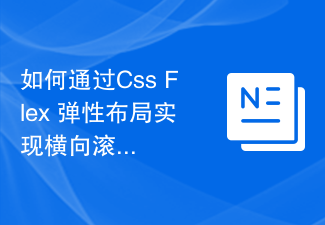 如何通过Css Flex 弹性布局实现横向滚动效果Sep 27, 2023 pm 02:05 PM
如何通过Css Flex 弹性布局实现横向滚动效果Sep 27, 2023 pm 02:05 PM如何通过CssFlex弹性布局实现横向滚动效果总结:在网页开发中,有时我们需要在一个容器中显示一系列的项目,并希望这些项目能够横向滚动。这时,可以利用CSSFlex弹性布局来实现横向滚动效果。通过简单的CSS代码调整容器的属性,我们可以轻松地实现这一效果。在本文中,我将介绍如何使用CSSFlex实现横向滚动效果,并提供具体的代码示例。CSSFl
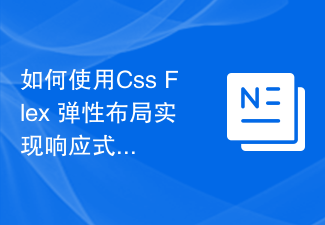 如何使用Css Flex 弹性布局实现响应式设计Sep 26, 2023 am 08:07 AM
如何使用Css Flex 弹性布局实现响应式设计Sep 26, 2023 am 08:07 AM如何使用CssFlex弹性布局实现响应式设计在当今移动设备普及的时代,响应式设计成为了前端开发中的一项重要任务。而其中,使用CSSFlex弹性布局成为了实现响应式设计的热门选择之一。CSSFlex弹性布局具有强大的可伸缩性和自适应性,能够快速实现不同尺寸的屏幕布局。本文将介绍如何使用CSSFlex弹性布局实现响应式设计,并给出具体的代码示例。
 详解Css Flex 弹性布局中的间距与空白处理方法Sep 26, 2023 pm 08:22 PM
详解Css Flex 弹性布局中的间距与空白处理方法Sep 26, 2023 pm 08:22 PM详解CSSFlex弹性布局中的间距与空白处理方法引言:CSSFlex弹性布局是一种非常方便和灵活的布局方式,它能够帮助我们轻松地创建响应式的网页布局。在使用Flex布局时,经常会遇到设置间距和处理空白的问题。本文将详细介绍如何在Flex布局中处理间距和空白,并提供具体代码示例。一、设置间距在Flex布局中,我们可以通过几种方式来设置间距。下面分别介绍这些
 如何通过Css Flex 弹性布局实现两栏布局Sep 26, 2023 am 10:54 AM
如何通过Css Flex 弹性布局实现两栏布局Sep 26, 2023 am 10:54 AM如何通过CSSFlex弹性布局实现两栏布局CSSFlex弹性布局是一种现代的布局技术,它能够简化网页布局的过程,使得设计与开发者们能够轻松创建出灵活且适应各种屏幕尺寸的布局。其中,实现两栏布局是Flex布局中的常见需求之一。在这篇文章中,我们将会介绍如何使用CSSFlex弹性布局来实现一个简单的两栏布局,并提供具体的代码示例。使用Flex容器和项目在使
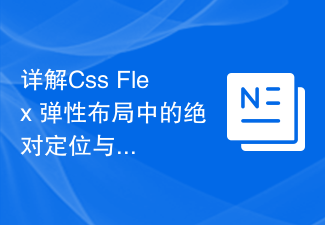 详解Css Flex 弹性布局中的绝对定位与层叠效果Sep 27, 2023 pm 01:58 PM
详解Css Flex 弹性布局中的绝对定位与层叠效果Sep 27, 2023 pm 01:58 PM详解CSSFlex弹性布局中的绝对定位与层叠效果导语:在CSS中,弹性布局(Flex)是一种非常强大的布局模型。它在垂直和水平方向上提供了灵活性,能够自适应不同的屏幕尺寸和设备。弹性布局也支持各种功能,包括绝对定位和层叠效果。本文将深入探讨CSSFlex弹性布局中绝对定位和层叠效果的使用和实现方法,并提供详细的代码示例。一、绝对定位(AbsoluteP
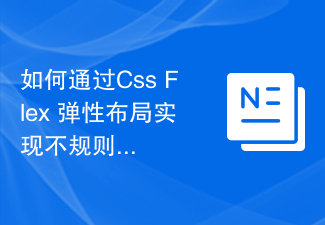 如何通过Css Flex 弹性布局实现不规则的网格布局Sep 28, 2023 pm 09:49 PM
如何通过Css Flex 弹性布局实现不规则的网格布局Sep 28, 2023 pm 09:49 PM如何通过CSSFlex弹性布局实现不规则的网格布局在网页设计中,常常需要使用网格布局来实现页面的分割和排版,通常的网格布局都是规则的,每个网格大小相同,而有时候我们可能需要实现一些不规则的网格布局。CSSFlex弹性布局是一种强大的布局方式,它可以很容易地实现各种网格布局,包括不规则的网格布局。下面我们将介绍如何利用CSSFlex弹性布局来实现不
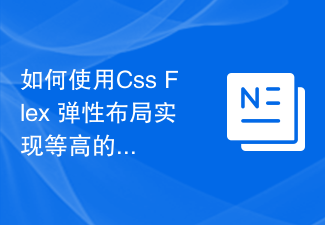 如何使用Css Flex 弹性布局实现等高的列布局Sep 27, 2023 pm 03:17 PM
如何使用Css Flex 弹性布局实现等高的列布局Sep 27, 2023 pm 03:17 PM如何使用CSSFlex弹性布局实现等高的列布局CSS弹性盒子布局(CSSFlexibleBoxLayout)简称Flex布局,是一种用于页面布局的模块。Flex布局可以让我们更轻松地实现等高的列布局,无论内容的高度如何,它们都能够等高显示。在这篇文章中,我们将介绍如何使用CSSFlex布局来实现等高的列布局。以下是具体的代码示例。HTML结构:&


Hot AI Tools

Undresser.AI Undress
AI-powered app for creating realistic nude photos

AI Clothes Remover
Online AI tool for removing clothes from photos.

Undress AI Tool
Undress images for free

Clothoff.io
AI clothes remover

AI Hentai Generator
Generate AI Hentai for free.

Hot Article

Hot Tools

SublimeText3 English version
Recommended: Win version, supports code prompts!

SAP NetWeaver Server Adapter for Eclipse
Integrate Eclipse with SAP NetWeaver application server.

WebStorm Mac version
Useful JavaScript development tools

SublimeText3 Linux new version
SublimeText3 Linux latest version

MinGW - Minimalist GNU for Windows
This project is in the process of being migrated to osdn.net/projects/mingw, you can continue to follow us there. MinGW: A native Windows port of the GNU Compiler Collection (GCC), freely distributable import libraries and header files for building native Windows applications; includes extensions to the MSVC runtime to support C99 functionality. All MinGW software can run on 64-bit Windows platforms.






